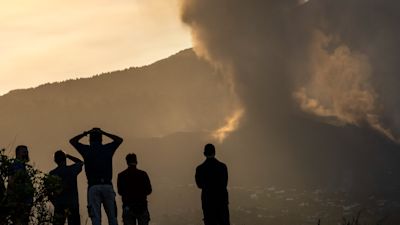La Palma: Three more towns evacuated as volcano eruption continues

Three more towns on the Spanish Canary Island of La Palma have been evacuated as a volcano continues to produce explosions and spew lava five days after it first erupted.
Authorities on the island of La Palma ordered people to leave the towns of Tajuya, Tacande de Abajo and the part of Tacande de Arriba that had not already been evacuated.
The government added there was an "increased risk to the population" of the area and advised residents to head to a nearby football field.
The warning comes as a new fissure spews out more fiery molten rock and loud bangs unnerve local people. As a precaution, emergency services have pulled back from the area.
Regional airline Binter temporarily halted flights due to a huge ash cloud.
On Tuesday, ITV News Correspondent Dan Rivers reported on swimming pools bubbling up as lava spread through the streets
The lava has destroyed almost 400 buildings on La Palma, including many homes, on the western side of the island of 85,000 people, a European Union monitoring program said.
It said the lava stretches over 180 square feet and has blocked 14 kilometres of roads. Islanders make a living mostly from farming and tourism, and some may lose their livelihoods.
The government of La Palma said officials had recorded 1,130 quakes in the area over the past week as the Cumbre Vieja volcanic ridge shook with blasts of lava.
On a visit to La Palma, Spanish Prime Minister Pedro Sánchez announced a package of measures to help get the island back on its feet and “rebuild lives".
The Spanish government will provide aid for rebuilding homes and public infrastructure, such as roads, irrigation networks and schools, as well as relaunching the island’s tourism industry, Mr Sánchez said.
He did not say how much money would be made available, but said a Cabinet meeting next week would provide more details.
The blasts are sending ash up to 4,500 metres into the air, the Guardia Civil police force said in a tweet. Local authorities advised people to protect themselves from the ash with face masks.
Two rivers of lava continued to slide slowly down the hillside, with experts doubting whether they would cover the remaining 2 kilometres to the sea due to their slowing progress.
One of the molten rock flows has almost ground to a halt and a second one is moving at between four and five metres an hour, the Guardia Civil said.
Both are at least 10 metres high at their leading edge and are destroying houses, farmland and infrastructure in their path.
Scientists say the lava flows could last for weeks or months.
Authorities haven’t reported any casualties from the eruption. Scientists had been monitoring the volcanic activity and had warned of a possible eruption, allowing almost 7,000 people to be evacuated in time.